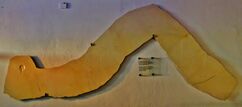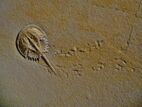Earth:Mortichnia
From HandWiki
A mortichnia left by a Mesolimulus walchi (on the far left), Jura Museum, Eichstätt
Closeup of the same Mesolimulus
A mortichnia is the "death march", or last walk, of a living creature.[1] These are sometimes preserved as fossil footprints.
Notable examples
In 2002 the mortichnia of a horseshoe crab was found in lithographic limestone in Bavaria, Germany .[2][1] The trail measured 9.7m and was left about 150 million years ago when the crab died in an anoxic lagoon.[1] The footprints left enough evidence for researchers to determine that the creature probably fell into the lagoon upside-down, righted itself, and started walking before succumbing to the anoxic conditions of the water.[1] The trackway is currently exhibited at the Wyoming Dinosaur Center.[3]
See also
- Kouphichnium, an ichnogenus attributed to horseshoe crabs
References
- ↑ 1.0 1.1 1.2 1.3 "Fossil records 'crab' death march". BBC. https://www.bbc.co.uk/news/science-environment-19514333. Retrieved September 7, 2012.
- ↑ Lomax, Dean R.; Racay, Christopher A. (2012). "A Long Mortichnial Trackway of Mesolimulus walchi from the Upper Jurassic Solnhofen Lithographic Limestone near Wintershof, Germany". Ichnos: An International Journal for Plant and Animal Traces 19 (3): 175-183. doi:10.1080/10420940.2012.702704.
- ↑ "Final Journey of the Horseshoe Crab: The Longest Mortichnial Trackway in the Fossil Record". https://artsandculture.google.com/exhibit/final-journey-of-the-horseshoe-crab/MAJy9saN4Q1qIQ.



